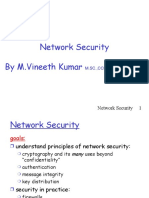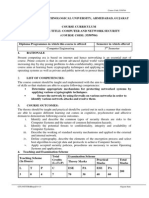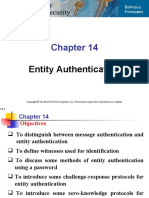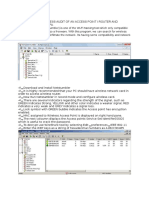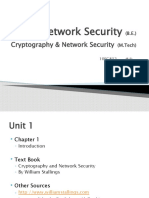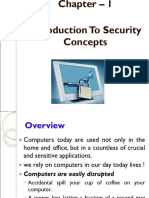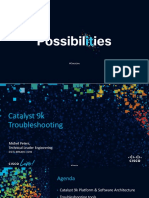Network Security and
Protocols
Chapter 18
�Chapter Objectives - I
Explain the different Network Security Threats
Explain the need for Network Security
Discuss the objectives of Cryptography
List the various types of Cryptosystems
Explain the concept of Digital Signatures
Identify the different Authentication Protocols
Chapter 18
�Chapter Objectives - II
Discuss the different methods of
ensuring privacy
Explain the concept of Firewall
Discuss the concept of VLAN
Explain the various Fault Tolerant And Redundancy
Methods
List the components of a Perfect Server
Demonstrate the implementation External Network
Security
List the different Network Security Protocols
Chapter 18
�Recall - I
The combination of centralized processing model
and distributed processing model is called the clientserver model
Advantages of light wave technology are:
Chapter 18
Cost effective solution
Offers very high bandwidth
Very easy to install
�Recall - II
The different remote access methods used are:
Using phone lines and modems
Using ISDN lines
Using X.25
Advantages of connectionless internetworking are:
flexibility, robust and no unnecessary overhead
The two process involved in routing are host routing
and router routing
Chapter 18
�Threats
Prevent users from accessing the required
resources for performing their work
Types of Threats
Internal
Chapter 18
External
�Internal Threats
Malicious practices done by the local networks
users that do not allow efficient sharing of the
network resources
Common internal threats are:
Chapter 18
Unauthorized Access
Data Destruction
Administrative Access
System Crash/Hardware Failure
Virus
�Protecting from Internal Threats
Methods of protecting internal threats largely
dependent on policies rather than technology
To protect the network from internal threats you need
to implement:
Chapter 18
Passwords
User Account Control
Policies
Fault Tolerance
�External Threats
External threats can exist in two forms:
Attacker manipulates the user to gain access to the
network
Hacker at a remote location uses technical methods
to gain illegal access to your network
Common external threats are:
Social Engineering
Hacking
Chapter 18
�Protecting from External Threats
Securing network from external threat is a
competition between hackers and security people
To protect the network from external threats you
need to provide:
Chapter 18
Physical protection
Firewalls
Encryption
Authentication
Public Keys and Certificates
VLAN
10
�Need for Network Security
Network security - Mechanism that protects the
network resources from being attacked by the
outside world
Hackers constantly look out for loopholes in the
network security and snoop into a network
Chapter 18
11
�Security Attacks - I
Break the security barrier of the network and access the
network resources
Types of Security
Attacks
Active
Chapter 18
Passive
12
�Case Study - I
The Customer Service department of MoneyMaker
bank provides online services to the customers. It
has been a month since maintenance tasks have
been performed on the computers of the
department at Hyderabad branch. The customer
service department of Hyderabad branch reports
that the response of the computers has become
slow and pop-ups continually plague Internet
browsers. The computers are infected with
spyware.
Chapter 18
13
�Problem
The performance of the computers in the costumer
service department has reduced
Chapter 18
14
�Suggested Solution
Spyware is software and not a virus that hides itself
somewhere on the computer and collects
information about the user. Spyware is often
downloaded onto the computer when you download
other free software or when you visit certain
Websites. To solve the problem the spyware can be
removed using a removal tool such as Spybot. This
will help in improving system performance.
Chapter 18
15
�Implementing External Network
Security - I
Implementing external network security was not
necessary while dial up connections were used
Arrival of high speed internet connection has
completely changed security aspect for home
computers
Users who use Asymmetric digital subscriber line
(ADSL) or a cable modem is the main target for the
hackers
Windows XP now has an Internet Connection Firewall
(ICF) available
Chapter 18
16
�Implementing External Network
Security - II
SOHO routers are connected to provide security to
networked systems sharing a single Internet
connection
Large networks employ a dedicated firewall between a
gateway router and the protected network
A demilitarized zone (DMZ) can also be
implemented to prevent access to the network
Chapter 18
17
�Cryptography
Cryptography is a science that deals with securing
information
Objectives of Cryptography are:
Chapter 18
Message Confidentiality
Message Integrity
Message Authentication
Message Nonrepudiation
Entity Authentication
18
�Types of Cryptosystems
Cryptographic systems consists of algorithms and
procedures used for encrypting the messages
Types of cryptographic systems:
Symmetric Cryptographic Systems
Asymmetric Cryptographic Systems
Symmetric Cryptographic Systems use same keys
for encryption and decryption
Asymmetric Cryptographic Systems use two keys,
one for encryption and other for decryption
Chapter 18
19
�Encryption/Decryption
Encryption refers to conversion of plain text into
cipher text
Cipher algorithm is used to transform plain text into
cipher text
Different types of traditional ciphers used to encode
the message fall in to two broad categories:
Chapter 18
Substitution ciphers
Transposition ciphers
20
�Public Key Encryption/Decryption
Uses a combination of two keys the private key
and the public key
Private key is known only to the receiver of the
message
Chapter 18
21
�Secret Key Encryption / Decryption
Uses the same key to encrypt and decrypt the
message
Algorithm used for decrypting the message is
inverse of algorithm that is used to encrypt message
Chapter 18
22
�Digital Signatures - I
Used to authenticate the origin of the document
Come under the asymmetric cryptography category
Can be accomplished in two ways:
Chapter 18
Signing the document
Signing the digest of the document
23
�Digital Signature - II
Signing the document
Signing the digest
Chapter 18
24
�Authentication Protocol
Authentication is a process by which the identity of
the concerned party is identified before starting the
communication process
Data traffic is encrypted using symmetric key
cryptography for performance reasons
Public key cryptography is used for developing
authorization protocols as well as creating a session
key
Chapter 18
25
�Authentication based on Shared Secret
Key -I
Challenge response protocols used for authentication
using shared secret key
Chapter 18
26
�Authentication using Kerberos
Three types of servers involved in Kerberos
protocol:
Chapter 18
Authentication Server (AS)
Ticket-Granting Server (TGS)
Real Server
27
�Authentication using Public Key
Cryptography
Certification Authority : Organization that binds a
public key to an entity and issues a certificate
Chapter 18
28
�Firewall - I
Firewall is a system that blocks all unwanted and
unauthorized access of the system resources
Firewall can be set using a router, switch, or a
bridge
Firewall is basically present at the junction point or
gateway between two networks like a private and
public network
Firewalls can be hardware or software
Basic types of firewalls are:
Chapter 18
Packet-Filter Firewalls
Proxy Firewalls
29
�Firewall - II
Demilitarized Zones in Firewall
Chapter 18
Network that is usually present between an internal
and external network of an organization
DMZ host provides services for external networks thus
providing cover for internal networks against intruders
30
�Case Study - II
Network administrator John has installed a new
Web browser on the computer of the employee in
the Mumbai branch of the MoneyMaker Bank. The
user complains to John that he is unable to connect
to the Internet using the new Web browser and a
firewall warning message appears.
Chapter 18
31
�Problem
Cannot view the Web pages on the new browser.
Chapter 18
32
�Suggested Solution
The Windows firewall might block a program from
connecting to the Internet. To solve this problem you
might need to add the program to the exception list
of the firewall.
Chapter 18
33
�VLAN - I
Individual broadcast domains created by the switch
are called virtual LANs.
Different characteristics used to group stations in a
VLAN are:
Port Numbers
MAC addresses
IP addresses
Multicast IP Addresses
Combination
IEEE standard 802.1Q defines format of frame
tagging in VLAN
Chapter 18
34
�VLAN - II
VLAN can be configured in three ways: Manual,
Automatic, and Semiautomatic
Three methods used for communication between
switches are:
Table Maintenance
Frame tagging
Time Division Multiplexing (TDM)
Advantages of VLAN are:
Network Management
Creating Virtual Work Groups
Security
Chapter 18
35
�Fault Tolerance and Redundancy
Shared data of a network should have better
protection rather than having to restore the backups
with difficulty
The capability of a server to continue operating in
case of a hardware failure is known as fault
tolerance
To implement fault tolerance you have to make the
data redundant on the serving system
Chapter 18
36
�RAID
RAID is a technology that uses a collection of hard
disks to share and replicate data
Different levels of RAID are RAID 0, 1, 2, 3, 4, 5, 6,
0+1, 10, 53 and linear RAID
Chapter 18
37
�Network-Attached Storage (NAS)
Used for implementing a server just for file sharing
A prebuilt system usually running LINUX with Samba
and/or Network File System (NFS)
Devices have DHCP enabled and require very little or
no configuration to run
Chapter 18
38
�Storage area network (SAN)
SAN is a network whose
primary aim is to transfer
data between disk arrays,
tape drives and servers
The various SAN
components are:
Chapter 18
Fiber channel Switches
Hosts and Host Bus
Adapters
Storage Devices
Cabling and Cable
Connectors
39
�Tape Backup
Tape backup becomes essential incase of a
hardware crash or damage to the server
Magnetic tape is the oldest method of storing data
from the computer
Tape backup options fall in to three major groups:
Chapter 18
Quarter-inch tape (QIC)
Digital Audio Tape (DAT)
Digital Linear Tape (DLT)
40
�Perfect Server - I
Network that shares data requires specialized
hardware so as to share data as fast as possible
Hardware requirement for Speed
Chapter 18
Fast NICS : Increasing the data throughput and
making it do more than one task at a time
Faster Drives : Using a PATA or a SCSI drive and
implementing RAID 5 for data protection
41
�Perfect Server - II
Servers require reliability, speed as well as data
protection
Good Power
Antivirus Program
Environment
Chapter 18
42
�Hardware Requirement for speed
The hardware requirements for a server and a
workstation differ from each other completely
Workstations do not require the speed, reliability
and data backup. Servers on the other hand require
reliability, speed, as well as data protection
The two things that can make the server provide
good speed are:
Chapter 18
Fast NICs
Fast Drives
43
�Reliability - I
A steady AC power supply is to be provided to all
the systems
The different methods of providing good power are:
Dedicated Circuits
Surge suppressors
Uninterruptible Power Supply (UPS)
Backup Power
Another problem along with faulty power is computer
viruses
Chapter 18
44
�Reliability - II
Five typical types of viruses are:
Boot sector
Executable
Macro
Trojan
Worm
Damage due to virus attacks can be prevented by
not allowing the virus from entering the system
Necessary to provide a good environment for the
server to improve its reliability
Chapter 18
45
�Protocols
Different protocols are used at different layers of the
OSI model for providing security to the users
The different protocols used are:
Chapter 18
Secure Socket Layer (SSL)
Internet Protocol Security (IPSec)
Point-to-Point Tunneling Protocol (PPTP)
Point-to-Point Protocol (PPP)
Serial Line Interface Protocol (SLIP)
46
�SLIP
Serial Line Internet Protocol (SLIP) is used to
connect the computer to the Internet using serial
connection such as the dial-up modem
Serial Line Internet Protocol was designed for Data
link protocol for telephony
However, SLIP only supported TCP/IP and not
NetBEUI or IPX network.
Chapter 18
47
�PPP - I
One of the common protocols for point to point
access
PPP addressed all of the shortcomings of SLIP
Different services provided by PPP are as follows:
Chapter 18
Defines the format of the frames to be exchanged
between devices.
Defines how the devices can negotiate for
establishment of link and exchange of data
Defines how network layer data is encapsulated in the
data link frame.
Defines how the devices can authenticate each other
48
�PPP - II
Provides multiple network layer services that
support different network layer protocols.
Provides connection over multiple links.
Provides network address configuration which is
useful incase a user needs a temporary network
address to connect to the Internet
Chapter 18
49
�PPTP
Network protocol that allows secure transfer of data
from a remote client to a private server
It is the Microsoft VPN encryption protocol
The three processes involved in PPTP are:
PPTP connection and communication
PPTP control connection
PPTP data tunnelling
Chapter 18
50
�IPSec
Protocol set that was developed by Internet
Engineering Task Force (IETF) for providing security
to a packet at the network level
IPSec operates in two modes:
Chapter 18
Transport Mode
Tunnel Mode
51
�SSL
SSL is a protocol developed by Netscape for
transmitting private documents over the Internet.
Web pages that use SSL have URLs starting with
https
Different services provided by SSL for the data
received by application layer are:
Chapter 18
Fragmentation
Compression
Message Integrity
Confidentiality
Framing
52
�Summary - I
There are two types of threats: Internal and External
threats
Internal threats are malicious practices done by the
local networks users that do not allow efficient
sharing of the network resources
External threats are threats in which a hacker at a
remote location uses technical methods to gain
illegal access to your network
Chapter 18
53
�Summary - II
Network security is a mechanism that protects the
network resources from being attacked by the
outside world
Security attacks can be passive or active
Cryptography is a science that deals with securing
information and involves securing of messages,
authentication, and digital signatures
Chapter 18
54
�Summary - III
Symmetric cryptographic systems use the same
keys to encrypt and decrypt the message
Asymmetric cryptographic systems use two keys
one for encryption and the other for decryption for
securely transmitting the data
In digital signatures private key is used to encrypt
the message and public key is used to decrypt it
Chapter 18
55
�Summary - IV
Authentication based on shared secret key uses
challenge response protocols
Encryption refers to conversion of plain text into
cipher text and the cipher algorithm is used to
transform plain text into cipher text
Decryption means converting cipher text back to
plain text and same cipher algorithms are used
decrypting
Chapter 18
56
�Summary - V
Public key encryption / decryption use public key to
encrypt the message and private key to decrypt the
message
Secret key encryption / decryption use the shared
secret key to encrypt and decrypt the message
Firewall is a system that blocks all unwanted and
unauthorized access of the system resources
Demilitarized zone (DMZ) is a network that is usually
present between an internal and external network of
an organization
Chapter 18
57
�Summary - VI
A Virtual local area network (VLAN) is a switched
network that is logically segmented with respect to
functions, project teams, or applications
IEEE standard used for VLAN 802.1Q defines the
format of frame tagging and the format to be used in
multi-switched backbones
Station in a VLAN can be configured in three ways:
manual, semiautomatic, and automatic
RAID uses different techniques of using multiple
devices for data protection and increasing the
speeds
Chapter 18
58
�Summary - VII
Network Attached Storage (NAS) is used for
implementing a server for file sharing
Storage area network (SAN) is a network whose
primary aim is to transfer data between computer
storage devices and computer systems
Tape backup becomes essential incase of a
hardware crash or damage to the server room
Chapter 18
59
�Summary - VIII
Perferct servers require reliability, speed, data
protection and specialized hardware
NIC can be made faster by increasing the data
throughput and making the NIC smarter by making it
do more than one task at a time
Reliability can be achieved by providing a secure
environment for the server and providing redundant
hardware components for the server in case of
component failure
Chapter 18
60
�Summary - IX
Small office/home office connection is a setup where
few networked systems share a single Internet
connection
SSL is designed to provide security and
compression services to data generated from the
application layer
IPSec is a protocol set that was developed by
Internet Engineering Task Force (IETF) for providing
security to a packet at the network level
Chapter 18
61
�Summary - X
Point-to-Point Tunneling Protocol (PPTP) is a
network protocol that allows secure transfer of data
from a remote client to a private server
Point-to-Point Protocol (PPP) is one of the common
protocols for point to point access
SLIP was designed to send IP datagram from one
device to another that were connected serially
Chapter 18
62
